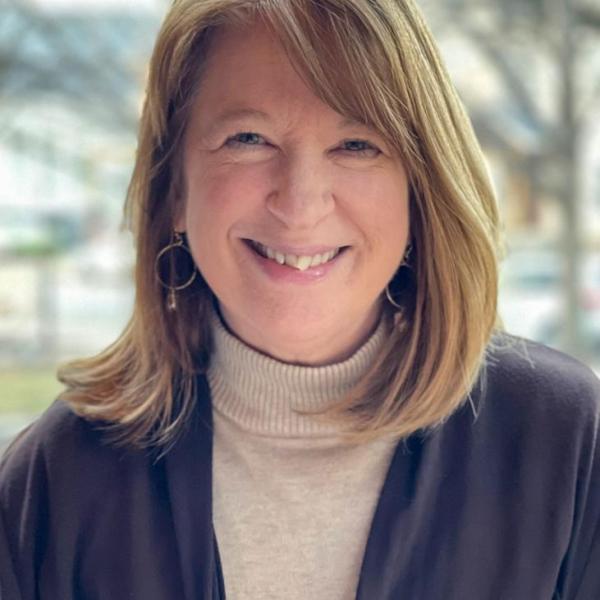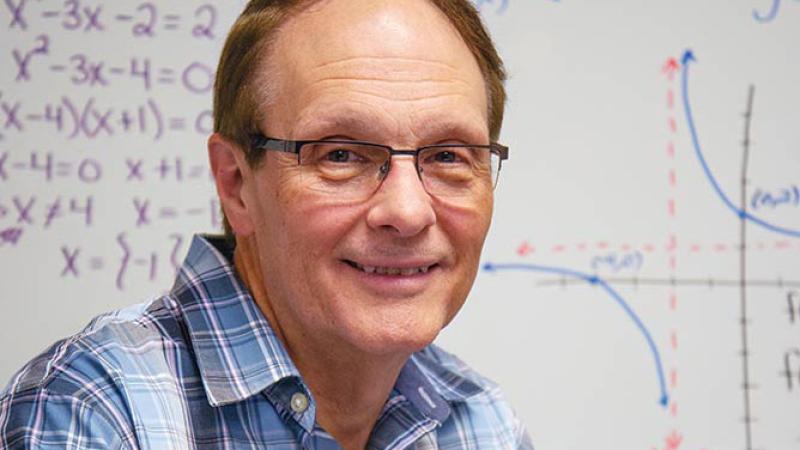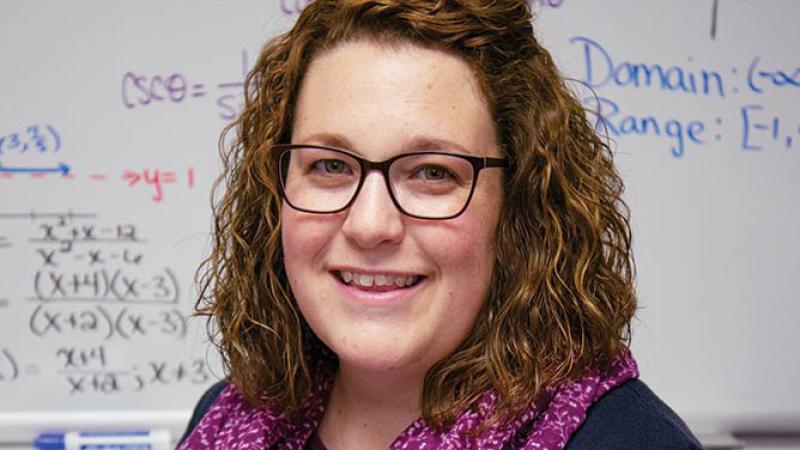Building science and sustainable design student Christine A. Limbert is among those benefiting from an experiment launched in 2016 that models a math course on the lecture-lab template of other Penn College classes.
Adding hope to math class
Published 03.23.2021

by Cindy Meixel
Writer/Editor Penn College News
There’s something akin to a quiet revolution happening inside the Klump Academic Center – the oldest building on the Pennsylvania College of Technology campus and home to innovation since 1914.
This transformation has been going on for about five years and has touched over 1,100 students enrolled in an enhanced version of MTH 180 – College Algebra and Trigonometry 1.
Consistent with similar college classes across the nation, success rates in this course have been historically low, but with the recent concerted effort, scores have risen in striking proportions.
Hearing about Penn College’s achievement, other universities are calling, asking for advice. They, too, want this equational elixir.
According to the Mathematical Association of America, only about 50 percent of students enrolled in college algebra earn a grade of A, B or C. As gateways to many STEM majors, algebra courses are crucial for preparing students to benefit society in a range of occupations.
Penn College’s experimental MTH 180 course has increased the percentage of students earning an A, B or C to 65% and those receiving a D or better to 84%. (Grades of D and higher permit students to pass.) One semester, the percentage of students earning a passing grade climbed to 90%.
The mathematical wizards behind this conversion are Ed Owens and Lisa D. Jacobs. Three other Penn College professors joined the endeavor as it evolved: Lauren Rhodes, Tiffany Schwanger and Nathan Trick.
From Fall 2016 through Fall 2020, 45 sections of the revised course have been taught by the five participating faculty members.
The educators are excited to see students’ math comprehension and confidence rising and their math scores increasing, along with opportunities for success in their chosen majors and careers.
“Our big question was: How do we reach the struggling student with a weak background and high math anxiety?” Owens explained.
“We know that the A and B students will most likely always be successful, but how can we target the C, D and F group?” Jacobs added. “Our focus was: How do we get that group to be more successful?”
More Time = Collaboration + Confidence
The first strategic change was to add more time to the class each week in the form of a lab component.
“All of their major courses follow the lecture-plus-lab model, with the lab tied to the lecture. We were simply modeling that structure, but in a mathematics context,” Jacobs said.
Following lab time, students are encouraged to continue collaborating at study spaces outside their professors’ offices. More than 50% of students have taken advantage of this extra offering.
With lab and study time allowing for enhanced interaction among students and between students and professors, a strong sense of community and camaraderie has emerged.
“The lab time, as well as the time spent with the professor and the other students outside of the class, was the biggest and most beneficial surprise,” said Scott R. Seneca, a civil engineering technology student from Lewisburg. “The structure of that class taught me to seek out help from the professors, as well as the student sitting next to me. The lab time broke the ice for students to realize that just because the person sitting next to you may have a better score on an assignment, doesn’t mean they didn’t struggle and seek help or that they wouldn’t help you in return.”
This culture of support has circled back into lecture time, where students feel more comfortable asking questions or responding to questions without fear of embarrassment. Students’ math anxieties have decreased and their confidence has flourished.
Practical Problems = Elevated Understanding
The second component of the retooled MTH 180 course model has focused on content. Owens and Jacobs had a strong desire to stress conceptual learning through the use of practical algebraic problems relating to students’ daily lives and fields of study. (Students in a transportation-related major might be determining measurements of a piston, while students in health sciences could be calculating dimensions of vertebrae.) Through the use of relevant problems, the faculty hoped students would see the value as it applies to their future careers.
“In architecture, there are many calculations that have to be done to ensure structural safety, and learning some of these concepts in MTH 180 better helped me in my core classes, especially when my math professor would make the equations a real-life scenario,” said Christine A. Limbert, a building science and sustainable design student from Curwensville.
Engineering design technology student Evan L. McElhenny, of Bainbridge, had similar experiences. The conceptual coursework helped him relate better and retain the information longer.
“The biggest thing this course helped me complete within my major was how to work out problems given to me when it came to figuring out unknown dimensions within a certain sketch or design,” McElhenny shared.
Another concerted effort has focused attention on the depth of the content in lieu of the breadth of material within the course.
Additionally, the faculty implemented lecture guides aimed at helping students stay organized. Jacobs says the guides provide students time to think and process without frantically trying to write everything down during a lecture.
This supplement to instruction helped Kaylei L. Hildebrandt, an electrical technology graduate who is enrolled in building automation engineering technology. Hailing from St. Leonard, Maryland, Hildebrandt is a Navy veteran.
“With how the note sheets were laid out and with how well my professor was able to explain the concepts, I was able to focus more on the lesson being taught,” she said, explaining that the lecture guides offer questions that work in tandem with the material the professor is covering; additional space for note-taking is also contained in the guides.
Adding Hope to the Equation
A third area of emphasis for the enhanced course model has been to inject a sense of hope into the classroom.
Aware that many students arrive on the first day of math class already feeling defeated or set up for failure, the educators believed it was necessary to infuse a nurturing atmosphere into the classroom from day one, creating a place where students feel safe to make mistakes.
“I tell the students: ‘You only learn when you’re making mistakes. If you’re not wrong, I have nothing to teach you,’” Owens said.
Jacobs added: “Our primary goal in all our effort was to provide hope and empower students for success.”
The elevation of students’ hope has positively merged with the one thing that benefits students the most within their mathematics courses: homework.
Many students, especially if they struggle with math, have difficulty taking the material learned in class and completing their homework. They often run into challenges finishing homework alone, get frustrated and give up on their assignments. This can “snowball” on them throughout the semester, leading to high withdrawal or high failure rates.
“Out of the confidence and content mastery from lab time, students are then more engaged and determined to complete their homework,” Jacobs said. “Completion of homework is one of the best catalysts for success within a mathematics course.”
Faculty Are Learning, Too
Trick says he joined the effort as a new faculty member because the level of student success was evident, and he was interested in the opportunity to interface with the other four professors teaching the enhanced MTH 180 model.
“I was very interested in the opportunity to collaborate with the other committee members on a weekly basis to discuss what was working and any changes that the group felt would better serve the course,” he said. “Discussing the different components of the course with my colleagues and sharing ideas with each other really helped me grow as an instructor.”
The group’s weekly meetings have supported the educators in creating consistency among their classrooms and providing an opportunity to share experiences, heading off challenges during the semester as opposed to waiting until the end.
“Teaching MTH 180 in the lecture/lab format has convinced me of how important it is for the students to have the opportunity to collaborate with each other and me during the lab time,” Trick added. “I have found that the more the students have the opportunity to discuss and work the mathematics with each other and their instructor, the more they understand the concepts being taught, which ultimately helps them become better problem solvers in general.”
This academic effort that began as a singular quest has moved in myriad directions and resulted in numerous unexpected benefits – similar to an equation yielding infinite solutions.
“The MTH 180 project demonstrates not only that the faculty at Penn College are experts in their field, but also that they are dedicated to their students,” said Sue A. Kelley, dean of the School of Business, Arts & Sciences. “I am continually impressed with the innovative methods that they develop to foster student understanding and success. The faculty involved in this project found a way to make math relevant and meaningful for students. The growth that they cultivated is remarkable. Perhaps the most extraordinary piece of this story is the fact that the math faculty are applying what they learned through the MTH 180 project to improve other courses within the department.”
The evolution of individual students continues to inspire Jacobs.
“The most significant impact that I have noticed has been a complete transformation of students’ attitudes as the semester unfolds. Every semester begins the same way: a class full of individual students. However, as the semester progresses, they slowly transform into a cohesive community working together to complete the course,” she said. “It is also my hope that, through the many classroom interactions between the students, they are not only garnering the mathematical conceptual knowledge, but also taking away many of the soft skills that will make them productive participants in whatever field they find themselves in in the future.”
With the incredible success of the MTH 180 pilot course, Jacobs is spearheading a new initiative to revise MTH 006 – Elementary Algebra II.
“It was our desire that this would be a catalyst to experience the same level of success and transformation in our STEM developmental course,” she said. The fully revised course will be renamed MTH 008 and implemented in Fall 2021.



Share your comments
Penn College Magazine welcomes comments that are on topic and civil. Read our full disclaimer.
We love hearing from you